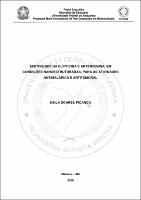| ???jsp.display-item.social.title??? |


|
Please use this identifier to cite or link to this item:
https://tede.ufam.edu.br/handle/tede/6495| ???metadata.dc.type???: | Tese |
| Title: | Efetividade da elipticina e artemisinina, em condições nanoestruturadas, para às atividades antimalárica e antitumoral |
| ???metadata.dc.creator???: | Picanço, Neila Soares  |
| ???metadata.dc.contributor.advisor1???: | Tadei, Wanderli Pedro |
| First advisor-co: | Grafov, Andriy |
| ???metadata.dc.description.resumo???: | A resistência parasitária aos fármacos antimaláricos comercialmente disponível é uma realidade, o que possibilita a busca por novas drogas e o desenvolvimento de pesquisas com plantas que possuem propriedades farmacológicas. As inúmeras discussões sobre as drogas antimaláricas de liberação rápida, vem ganhando força e adesão, pois apresenta vantagens relacionadas a sua eficácia, especificidade e tolerância por parte do paciente na terapia. Desta forma, a nanotecnologia oferece ferramentas importantes para o desenvolvimento de novos fármacos e as nanopartículas podem contribuir para uma terapia mais específica de ação seletiva na distribuição e absorção das drogas. De acordo com a biodiversidade Amazônica, o príncipio ativo, elipticina envolvida em pesquisas como antimalárico foi isolado da Aspidosperma vargasii, cujo nome popular é Amarelão ou Carapanaúba branca. A elipticina apresenta atividade antiplasmodial que foi demonstrado em teste in vitro, pois inibiu o crescimento do cristal de heme que ocorre no vacúolo digestivo do Plasmodium ssp. e está associado ao crescimento do parasito. Outro princípio ativo, que é extraído da Artemisia annua L. é a artemisinina. É considerada fundamental no tratamento da malária, por sua potência e sua rápida ação. As intervenções da terapia combinada baseada em artemisinina, diminuíram a morbidade e a mortalidade associadas a malária em várias partes do mundo. As combinações de artemeter-lumifantrine, artesunato-mefloquina e artesunato-amodiaquina, está relacionado a propriedades gametocitócidas da artemisinina que inibe a transmissão de parasitas para provavelmente reduzir o desenvolvimento de resistência antipalúdica. Recentes estudos mostram que o artesunato pode ser uma boa alternativa para o tratamento de alguns tipos de câncer, pelo mecanismo antiangiogênico. A sua baixa toxicidade representa um quimioterápico promissor. É importante salientar que o artesunato não é transportado por P-glicoproteínas, portanto não está envolvido em resistência a multidrogas. Na luta contra essas patologias, são apontados vários inconvenientes para o paciente como alguns efeitos adversos e horário de dosagens. Assim, considera que a avaliação de novos sistemas de liberação de medicamentos podem melhorar a eficácia terapêutica de futuras nanoformulações para fármacos antimaláricos e antitumorais. Neste sentido, este trabalho tem por objetivo desenvolver, caracterizar e avaliar as nanopartículas no seu aspecto físico-químico e citotóxico por meio de bioensaios contra Plasmodium falciparum e células antitumorais. As substâncias utilizadas na síntese das nanoesferas foram sódio tetracloropaládio e cloridrato de elipticina. As substâncias envolvidas na síntese das nanofibras foram o cloridrato de artemisinina, polyvinilpirrolidona e polibutileno. |
| Abstract: | Parasite resistance to commercially available antimalarial drugs is a reality, which makes it possible to search for new drugs and to develop researches with plants that have pharmacological properties. Numerous discussions on rapidlyreleasing antimalarial drugs have been gaining strength and adherence, as it has advantages related to its efficacy, specificity and patient tolerance in therapy. In this way, nanotechnology offers important tools for the development of new drugs and nanoparticles can contribute to a more specific therapy of selective action in the distribution and absorption of drugs. According to the Amazonian biodiversity, the active principle, ellipticina involved in research as antimalarial was isolated from Aspidosperma vargasii, whose popular name is Amarelão or Carapanaúba branca. Ellipticin exhibits antiplasmodial activity that has been demonstrated in in vitro test because it inhibited the growth of heme crystal that occurs in the digestive vacuole of Plasmodium ssp. and is associated with parasite growth. Another active principle, which is extracted from Artemisia annua L. is artemisinin. It is considered essential in the treatment of malaria, by its potency and its rapid action. Interventions of artemisinin-based combination therapy have reduced morbidity and mortality associated with malaria in several parts of the world. The combinations of artemeter-lumifantrine, artesunate-mefloquine and artesunateamodiaquine, are related to artoisinin's gametocytocidal properties that inhibit the transmission of parasites to probably reduce the development of antimalarial resistance. Recent studies show that artesunate may be a good alternative for the treatment of some types of cancer by the antiangiogenic mechanism. Its low toxicity represents a promising chemotherapeutic. It is important to note that artesunate is not carried by P-glycoproteins, so it is not involved in multidrug resistance. In the fight against these pathologies, several inconveniences are pointed out for the patient as some adverse effects and dosing schedule. Thus, it considers that the evaluation of new drug release systems can improve the therapeutic efficacy of future nanoformulations for antimalarial and antitumor drugs. In this sense, this work aims to develop, characterize and evaluate nanoparticles in their physico-chemical and cytotoxic aspect by means of bioassays against Plasmodium falciparum and antitumor cells. The substances used in the synthesis of the nanospheres were sodium tetrachloropalladium and ellipticine hydrochloride. The substances involved in the synthesis of nanofibers were artemisinin hydrochloride, polyvinylpyrrolidone and polybutylene. |
| Keywords: | Elipticina Antimaláricos e antitumorais Artemisinina Nanopartículas Ellipticina Artemisinin Nanoparticles Antimalarials and antitumorals |
| ???metadata.dc.subject.cnpq???: | CIÊNCIAS BIOLÓGICAS |
| Language: | por |
| ???metadata.dc.publisher.country???: | Brasil |
| Publisher: | Universidade Federal do Amazonas |
| ???metadata.dc.publisher.initials???: | UFAM |
| ???metadata.dc.publisher.department???: | Instituto de Ciências Biológicas |
| ???metadata.dc.publisher.program???: | Programa de Pós-Graduação em Biotecnologia |
| Citation: | PICANÇO, Neila Soares. Efetividade da elipticina e artemisinina, em condições nanoestruturadas, para às atividades antimalárica e antitumoral. 2018. 58 f. Tese (Doutorado em Biotecnologia) - Universidade Federal do Amazonas, Manaus, 2018. |
| ???metadata.dc.rights???: | Acesso Aberto |
| ???metadata.dc.rights.uri???: | http://creativecommons.org/licenses/by-nc-nd/4.0/ |
| URI: | https://tede.ufam.edu.br/handle/tede/6495 |
| Issue Date: | 27-Feb-2018 |
| Appears in Collections: | Doutorado em Biotecnologia |
Files in This Item:
| File | Description | Size | Format | |
|---|---|---|---|---|
| Tese_Neila S. Picanço | 1.56 MB | Adobe PDF |  Download/Open Preview |
This item is licensed under a Creative Commons License





